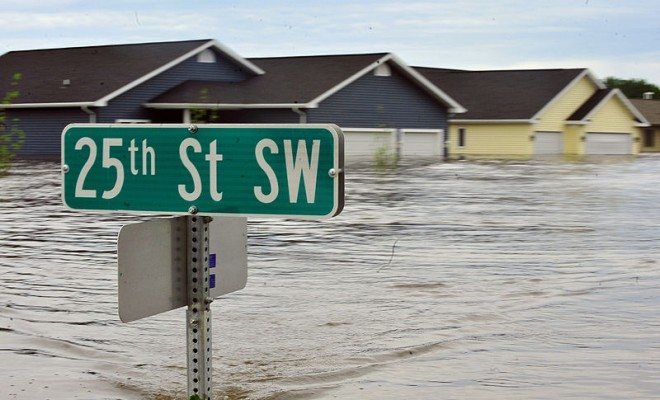 Image courtesy of [DVIDSHUB via Wikimedia]
Image courtesy of [DVIDSHUB via Wikimedia]
Energy & Environment
American Flood Insurance: The Biggert-Waters Act and Beyond
The Biggert-Waters Flood Insurance Reform Act was passed in 2012 in an attempt to save the failing National Flood Insurance Program (NFIP) that was deeply in debt and spiraling toward insolvency. As a result, homeowners in flood-prone areas, many of whom had never legally been in a flood zone prior to FEMA’s re-mapping efforts under the act, were required to buy flood insurance at outrageous premiums, with some homeowners seeing a 55 percent increase in their annual premiums. As a result, Congress has stepped in to delay Biggert-Waters’ implementation until these unforeseen side effects can be mitigated, though we have yet to see how this will be done. Read on to learn about the Biggert-Waters Act, flood insurance in the U.S., and what the next steps are.
How does flood insurance work?
While most of us know insurance is often sold by private companies consisting of comedic cavemen and geckos with accents, many types of insurance exist that are sold directly by or backed by the federal government, sometimes in conjunction with private companies. The National Flood Insurance program sells flood insurance, a highly risky type of insurance that most companies normally would not want to sell. It is sold through private insurers who perform the administrative work concerning policy issuance and premium collection, while the federal government collects the final premiums and pays all claims. Homeowners in designated flood zones are required to purchase this insurance, and since its creation in 1968 many policies are partially subsidized by the government to keep premiums reasonable. As of 2011, the program had 5.6 million policies in effect and $1.246 trillion in total insured value. Watch this adorable commercial created by the NFIP (who knew flood insurance could be cute?)
What is the Biggert-Waters Act?
The Biggert-Waters Flood Insurance Reform Act of 2012 was a piece of bipartisan legislation aiming to correct growing problems with the NFIP by bringing premiums in line with the actual risks they represented, and to establish flood zones that coped with the effects of climate change. As government subsidies of flood insurance premiums continued, the amount policyholders were paying into the program became gradually less commensurate with the actual risks being insured. Prior to the passage of Biggert-Waters, many flood insurance policies were subsidized. Despite this, the NFIP had remained stable until Hurricanes Katrina and Sandy struck the Gulf Coast and the Eastern Seaboard, requiring massive claims payments in addition to disaster relief, which severely depleted the resources keeping the NFIP afloat. After Hurricane Sandy, the NFIP needed $28 billion in bailouts, and currently the program is running $24 billion in the red.
Biggert-Waters sought to reform the National Flood Insurance Program in a number of ways. The bill aimed to increase the amount subsidized homeowners pay for their insurance, bringing the premiums paid in line with the actual risks and generating more revenue for the bankrupt NFIP. The NFIP would also no longer be able to provide a free pass for homes built before the NFIP came into effect, which had previously been grandfathered into the program. The program also commenced an extensive re-mapping project to make more homeowners aware of shifting and growing flood zones and to encourage them to purchase flood insurance, instead of remaining unaware until they require federal disaster aid. These mapped flood zones, as they had before Biggert-Waters, impose strict regulations on new home construction that require homes to be built at certain heights or with various loss-prevention methods. All of these reforms were meant to stabilize the NFIP financially and to accurately insure actual flood risks, reducing the strain on federal disaster relief funds.
Why is there an effort to delay Biggert-Waters?
Some unforeseen side effects of the Biggert-Waters Act have caused many politicians, including Representative Maxine Waters (one of the bill’s authors), to seek a delay in implementation of the bill. She, and others, have done so through the Homeowner Flood Insurance Affordability Act of 2014, which amends and delays the effects of Biggert-Waters. As a result of the re-mapping done by FEMA, many homeowners have found themselves in a higher-risk flood zone than they had been previously, which have stricter requirements governing the construction of homes, such as the height to which homes should be raised and the addition of flood vents or break-away walls. If these requirements are not met, a homeowner’s insurance premium can skyrocket.
Such was the case with Richard and Sandra Drake of Union Beach, New Jersey, who saw their annual flood insurance premium jump from $598 in 2013 to $33,000 in 2014 after they were re-mapped into a higher-risk zone. After Hurricane Sandy, the couple rebuilt their home and raised it three feet above the federal requirements for their flood zone. After re-mapping, however, their home was too low for the requirements of their new flood zone, and this was reflected in their annual premium. The new premium threatened to force them to sell and find a new home before Senator Robert Menendez stepped in and worked with FEMA to lower their premium back to pre-mapping rates. New York was forced to set up the Special Initiative for Rebuilding & Resiliency to combat the hikes in rates. Even residents whose homes are built to federal regulations may see premium increases. These rates simply are not feasible for many people who rely on federal flood insurance, which covers regions that range from secondary beach houses to low-income coastal communities.
How is Biggert-Waters being modified?
In 2014 Congress passed the Homeowner Flood Insurance Affordability Act (HFIAA), which repeals and modifies the Biggert-Waters Flood Insurance Act. It limits rate increases to 18 percent annually to prevent steep jumps in premiums while mandating increases to subsidized policies, in order to create a more gradual and cushioned path toward the end results sought by Biggert-Waters. It also provides options for homeowners placed into higher-risk flood zones in the new FEMA maps to become eligible for Preferred Risk Policies (PRP), which help lower individual homeowners’ premiums. In addition, it reinstates “grandfathering” in order to help those homeowners who have been re-mapped into higher-risk flood zones.
In essence, the HFIAA is meant to move toward some of the goals of Biggert-Waters at a more gradual pace, allowing homeowners to grow accustomed to unsubsidized rates instead of being confronted with them all at once; however, many homeowners point out that, while gradually achieved, the future unsubsidized premiums will still be too much to pay in high-risk areas, especially in later years when many homeowners will be living on fixed incomes. While the HFIAA cushions the blow of Biggert-Waters, it does not altogether remedy the controversy.
Who opposes the HFIAA?
Critics of the HFIAA argue that the continued subsidies on homes in high-risk areas leave communities unprepared when the next disastrous flood strikes. By paying unrealistic premiums, critics believe homeowners will be less proactive in elevating their homes, constructing their homes with preventive measures, and working with insurance agents to find a workable financial solution to flood insurance. Many critics also oppose “grandfathering,” in which policies created before the NFIP was implemented in a given community receive lower rates, instead of being prompted to modify their home to be more prepared for potential floods. In response to homeowners who claim that modifying their older homes may not be financially or physically feasible, these critics argue that the effort and resources required to modify a home are negligible in comparison to the effort and resources required to rebuild after a devastating flood. In all, critics are disappointed with a Congress that triumphantly passed bi-partisan legislation aimed at balancing the federal budget, and when citizens began to complain, “bowed to short-term constituent demand.”
Why do we continue to build homes and live in flood-prone areas?
When digesting all of this information one might be prompted to wonder, “Why don’t people simply move away from flood zones? And why are people living there in the first place?” The answer, as is the case with most socio-political questions, is not so simple.
Many homeowners find themselves in flood zones because, historically, cities were often built along rivers or the coast for the accessibility of water transportation. The areas affected by Hurricanes Katrina and Sandy are located near cities–New Orleans and New York, respectively–that rose to prominence due to their accessible harbors, and now these metropolitan areas, suburbs and all, are at the mercy of storm surges and fluctuating rivers and coastlines. In the modern era, prompting entire communities to pack up and move is simply not practical. Many of these communities date back decades and are multi-generational, making it difficult to abandon the area for higher ground. Many new development projects are also taking place in these areas because they are often profitable regions. A beach or a river valley can be an important tourist destination, and so construction in these areas continue despite the risk and the rising cost of flood insurance.
Opponents to flood-zone development are becoming more vocal, however, and are questioning why these areas remain filled with homes. At a certain point, opponents argue, the cost of living in flood zones will become too great and populations will be forced to evacuate. The United States is not the only country struggling with the question over the habitation of flood zones. Severe flooding that affected various parts of the British Isles in February 2014 caused a storm of political bickering and thorough media coverage. Many sources condemned coastal townships and politicians alike for lack of preparedness and for the approval of new development projects in flood zones. Thirteen percent of all new development projects in the United Kingdom in February 2014 were on flood plains, despite well known flooding in those areas. Similar to the U.S., the British government partnered with the Association of British Insurers to create a not-for-profit company to keep flood insurance available and affordable for the U.K.’s citizens. While the dispute over flood-plain communities has existed and will exist for some time, the impending insolvency of the National Flood Insurance Program demands immediate action.
Resources
Primary
House of Representatives: Biggert-Waters Flood Insurance Reform Act of 2012
House of Representatives: Homeowner Flood Insurance Affordability Act of 2014
Additional
USA Today: Flood Insurance Bill Clears Congress
Think Progress: How the New Flood Insurance Reforms Make Costly Future Climate Disasters More Likely
Times Picayune: How Controversial Biggert-Waters Flood Insurance Bill Became Law
Insurance Journal: Rep. Waters, Author of Flood Reform Act, Calls for Delay in Implementation
PropertyCasualty360: House, Senate Reject Efforts to Delay NFIP Rate Increases
Union of Concerned Scientists: The Biggert-Waters Act: Fix it, Don’t Abandon it
The New York Times: Outrage as Homeowners Prepare for Substantially Higher Flood Insurance Rates
The New York Times: Homes in Flood Zone Double in New FEMA Map
Independent: Why Do We Insist on Building on Floodplains?
Architects Journal: Flood Debate: Should We Build on Floodplains?
BBC: Why Do People Buy Houses in Places Prone to Flooding?








Comments